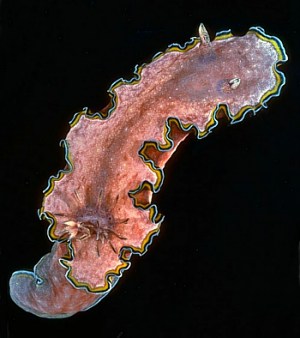
Glossodoris cincta
(Bergh, 1888)
Order: NUDIBRANCHIA
Suborder: DORIDINA
Superfamily: EUDORIDOIDEA
Family: Chromodorididae
DISTRIBUTION
Indo-West Pacific
PHOTO
UPPER: Banc Japonais, off Nickel Refinery, Nouméa, New Caledonia, 14m, 14 October 1988. Photo: Bill Rudman.
LOWER LEFT: Christmas Is., Indian Ocean, 28mm long. december 1980. Photo: J.Hicks.
LOWER RIGHT: Dar es Salaam, Tanzania, 51mm long alive, June 1976. Photo: Bill Rudman.
This widespread Indo-West Pacific species seems to have three regional colour forms. The southwest Pacific form (upper right photo) has a mottled brown body with bluish white (outer), then black, then yellow (inner) bands on the heavily folded mantle edge, and the foot. The Philippines - Indonesia colour form (lower left photo) has a bluish outer band on the mantle edge but the inner black and yellow lines tend to merge into a dull khaki band. The East African animals (lower right photo) lack a distinct bluish white band at the mantle edge.
Reference:
• Rudman, W.B. (1986) The Chromodorididae (Opisthobranchia: Mollusca) of the Indo-West Pacific: the genus Glossodoris Ehrenbergh (= Casella, H.& A. Adams). Zoological Journal of the Linnean Society, 86: 101-184.
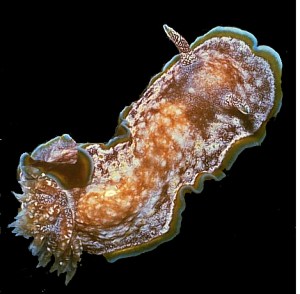
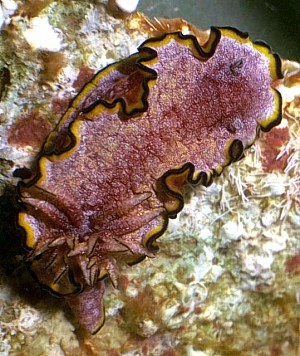
Rudman, W.B., 2000 (March 20) Glossodoris cincta (Bergh, 1888). [In] Sea Slug Forum. Australian Museum, Sydney. Available from http://www.seaslugforum.net/find/gloscinc
Related messages
Glossodoris cincta from the Red Sea
September 2, 2009
From: Marcel Tanke
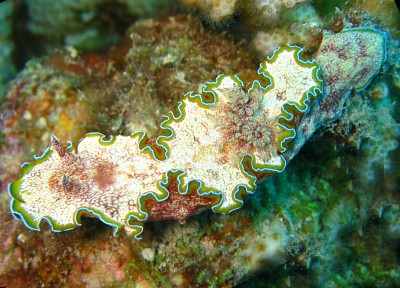
Concerning message #16937:
Dear Bill,
You have several messages and pictures of Glossodoris cincta on the forum already. But as the 2 pictures attached show great details and colors, I cannot resist sending you these.
Locality: Beachdive Coral Bay Resort, Safaga, 18 meters, Egypt, Red Sea, 27 July 2009, Sandy bottom, coral garden . Length: about 10 cm. Photographer: Marcel Tanke.
The first pictures also shows one of the oral tentacles.
Are the white, flake-like cells on the body the glands that release the defensive chemicals?
Best regards,
Marcel
marceltanke@cs.com
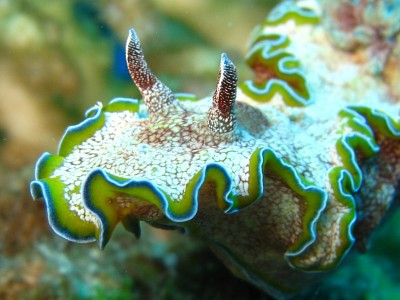
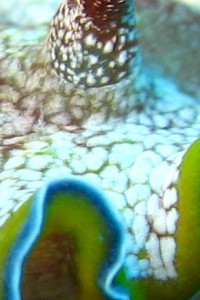
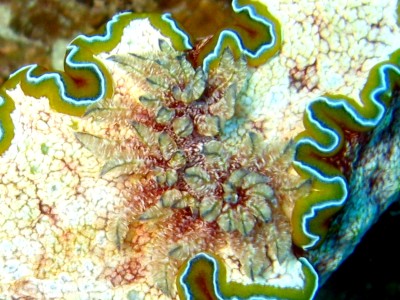
Thanks Marcel,
There was some earlier discussion [#19076] on the identity of the animal in the message your refer to [# 16937]. It looks like the common Indonesian-Philippines form rather than the east African form which you might expect in the Red Sea. However I am sure that will all come clearer as we learn more about these species.
Your question about the white patches on the skin gives me an opportunity to discuss a very interesting question concerning the genus Glossodoris. When I reviewed this genus some years ago the anatomy suggested we could separate the species in the genus into 3 or 4 subgroups based on differences such as radular morphology and nature of the mantle glands. As they all had very similar reproductive systems distinct from other chromodorids I decided to leave them in one genus. However, as you all have no doubt experienced, taxonomy can change when new facts become available, and I suspect the genus Glossodoris is one area where changes can be expected.
As I have discussed often, most chromodorids have special sacs in their skin - which I call mantle glands, and others call mantle dermal formations - in which they store distasteful chemicals from their food sponges to use defensively. In each genus these glands have a particular shape and arrangement. In the genus Glossodoris we find species with quite different gland types, which is one of the reasons I suspect there is more than one genus. In G. atromarginata for example, there are a few large glands deeply embedded in the mantle skirt while in G. cincta (and a few other species) the 'glands' are arranged in patches on the surface of the skin as is so well illustrated in your photos. There is a good photo of the defensive chemicals streaming form these patches in an earlier message [#8859]
Best wishes,
Bill Rudman
Glossodoris gregorius - or is it?
April 2, 2009
From: Déwald Swanepoel
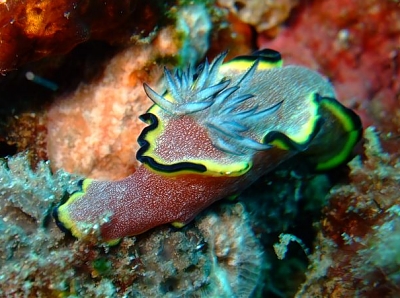
Dear Bill,
I've photographed this nudibranch at Ponta Malongane in southern Mozambique. I have tried to identify it and was given some good pointers by other divers but I'm still confused.
Locality: Ponta Malongane, 16 metres, Mozambique, Indian Ocean, 29 March 2009. Photographer: Déwald Swanepoel.
While I think I have the species down now, I'm unsure what the "real" name is. I don't even know if this is a matter of taxonomy or just latin grammar but the three candidates that I'm left with are
Glossodoris gregorius - cf. Rudman
Glossodoris gregoria - cf. Coleman
Glossodoris plumbea - cf. Debelius/Kuiter
I would very much appreciate your clarification in this regard.
Regards,
Déwald Swanepoel
dewald.swanepoel@gmail.com
Swanepoel, D, 2009 (Apr 2) Glossodoris gregorius - or is it?. [Message in] Sea Slug Forum. Australian Museum, Sydney. Available from http://www.seaslugforum.net/find/22382Dear Déwald,
Some of these species of Glossodoris are difficult to separate externally but I am 99% sure that this is what I have called on the Fact Sheet the East African colour form of Glossodoris cincta. Glossodoris gregorius is very similar in colour, but the shape and heavy denticulation of its teeth and bifid jaw plates are quite different. I considered the possibility that the difference in the teeth were because of its small size, but the few small specimens of G. cincta I had available to study didn't show such denticulation. It is certainly something that needs following up, but at present I would identify your animal as G. cincta.
Best wishes,
Bill Rudman
Glossodoris cincta from the Solomon Ids
December 12, 2008
From: Barbara Hanchard
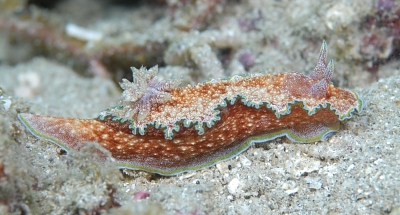
Dear Bill,
As you would expect the Solomon Islands Glossodoris cincta of the three colour groups is the same as those in Papua New Guinea & Bali. So for distribution records attached are photos of two found in the Solomon's. Both in a hurry to go somewhere so no details on possible food source.
Locality: Leilei, Honiara, 12 meters, Solomon Islands, Pacific, 4 & 6 December 2008, Sandy slope. Length: 80 mm & 60 mm. Photographer: N. Barbara Hanchard.
Regards
Barbara
nbhanchard@gmail.com
Hanchard, N.B., 2008 (Dec 12) Glossodoris cincta from the Solomon Ids. [Message in] Sea Slug Forum. Australian Museum, Sydney. Available from http://www.seaslugforum.net/find/22095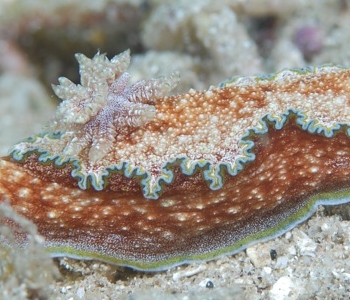
Thanks Barbara,
Best wishes,
Bill Rudman
Glossodoris cincta - with some extrusion
April 25, 2008
From: Riaan Marx
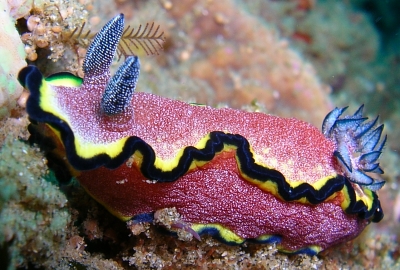
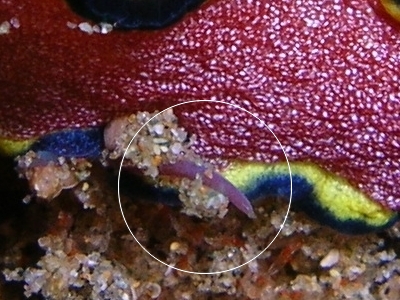
Good morning Bill,
I have two photos of Glossodoris cincta, but with a weird extrusion on the side. At first I thought it might be the reproductive organs, but is this not the wrong side of the body? All photos I have taken of Nudibranchs mating, the reproductive organs were on the right side and this is on the left side of the body.
Locality: Sodwana, 25 metres, South Africa, Indian Ocean, 18 August 2007, Rocky reef with sandy patches. Length: 25mm. Photographer: Riaan Marx.
Riaan Marx
riaan.marx@gmail.com
Marx, R., 2008 (Apr 25) Glossodoris cincta - with some extrusion. [Message in] Sea Slug Forum. Australian Museum, Sydney. Available from http://www.seaslugforum.net/find/20615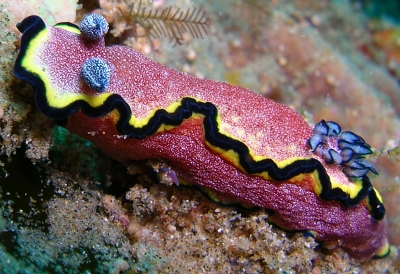
Dear Riaan,
It's nice to get some photos of this western Indian Ocean colour form of G. cincta. Concerning the 'extrusion' you mention. If it is the object I have 'ringed' in a close-up from your photo then I am pretty sure it is some worm just under the Glossodoris. Perhaps it is emerging from its burrow? It is probably a polychaete but I can't see enough to be sure.
Best wishes,
Bill Rudman
Glossodoris cincta from North Sulawesi
May 28, 2007
From: Mirjam Broos
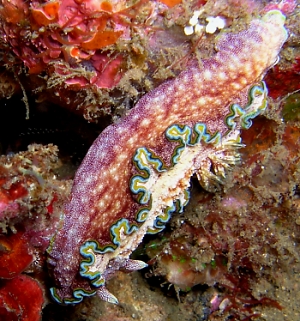
Hi Bill,
During a nightdive we found another beautiful slug which I can't identify. I'm sure you can help me.
Locality: Lembeh Strait, Nudi Falls, North Sulawesi, Indonesia, 09-10-2006, muckdiving. Photographer: Geert Prast.
Thanks,
Mirjam
mirjam.broos@planet.nl
Broos, M., 2007 (May 28) Glossodoris cincta from North Sulawesi. [Message in] Sea Slug Forum. Australian Museum, Sydney. Available from http://www.seaslugforum.net/find/19468Dear Mirjam,
This is a colour form of Glossodoris cincta.
Best wishes,
Bill Rudman
Glossodoris cincta feeding record
March 15, 2007
From: Richard Swann
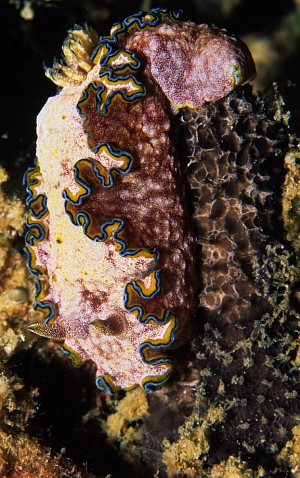
Hi Bill
I think that this is a record of Glossodoris cincta feeding for you. I tried my best to get a shot as I had just read on your forum that you could do with more information regarding these slugs. It looks to me that the sponge has been eaten judging by the ligher patches and small holes what do you think ?
Locality: Mamutik island,Kota Kinabalu, 8 meters, Sabah, Borneo, South China Sea, 2nd March 2007, coral rubble slope, sheltered reef. Photographer: Richard Swann
Best regards
Richard
richard@downbelow.co.uk
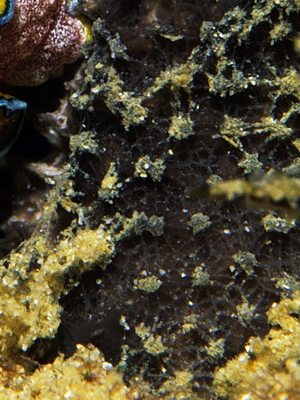
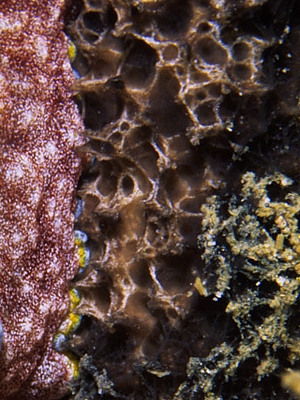
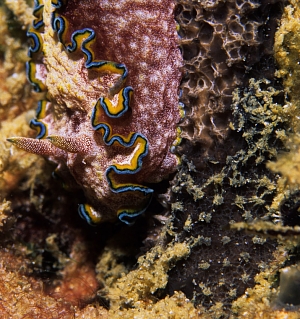
Dear Richard,
An excellent find! I agree that this is a partially eaten sponge colony. I have included two close-ups to show the uneaten part [middle left photo] and the part that has been 'grazed' [middle right photo]. It certainly looks like a thorectid sponge, possibly a species of Semitaspongia, but I will send it off to a sponge expert for identification.
Best wishes,
Bill Rudman
Re: Glossodoris cincta from the Red Sea
January 5, 2007
From: Lior Harari
Concerning message #16937:
Dear Bill,
I've looked at the Glossodoris cincta Fact sheet and it seems to me that the picture in my above message is most similar in color to the Pacific version of the slug (the back is white rather then purple and it has light bluish line around the mantle).
This surprises me, because I would expect a slug from the Red Sea to be related to the Indian ocean version. I would like to hear your opinion on the subject.
Thanks,
Lior.
hararilior@yahoo.com
Harari, L., 2007 (Jan 5) Re: Glossodoris cincta from the Red Sea. [Message in] Sea Slug Forum. Australian Museum, Sydney. Available from http://www.seaslugforum.net/find/19076Dear Lior,
Looking back at your message I should have said something other than just agreeing with your identification. The most important fact to know is that we don't know everything about these animals - in fact we know very little. I have been studying the chromodorids, including Glossodoris, from almost 40 years and I'm still not certain what is going on with the Glossodoris cincta group of species. There are a group of similarly coloured species including G. gregorius, G. pullata, G. plumbea, G. hikuerensis and the colour forms of G. cincta. One of the problems of sorting these species out is the lack of material with good accompanying colour photos. A number of times I have dissected a specimen which I am confident is one species only to find a quite different radular morphology. If you have good colour information on an actual specimen you can link that to the radular information and so start to define a 'species'. Unfortunately often we have preserved specimens which look quite like ' G. cincta' in their preserved state but we have no idea what they look like alive. Unfortunately you can also have two similar looking specimens collected at the same time and preserved together, but only one has been photographed - and there is no sure way to know which preserved specimen is in the photo, if they turn out to be different species.
Photos like yours, although not solving problems, are helping to define the nature of the problem we still have to solve. I suspect your animal from the Red Sea is not G. cincta but it's my best guess at present.
Best wishes,
Bill Rudman
Glossodoris cincta from South Africa
January 5, 2007
From: Lior Harari
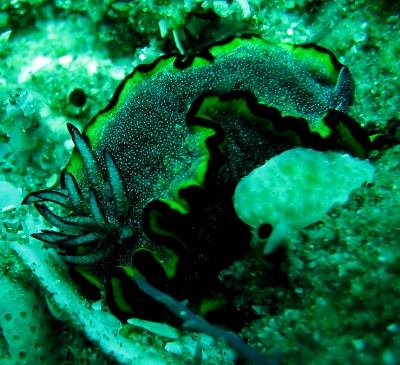
Hi,
This I believe is a Glossodoris cincta. It reminded me of the slug I have seen in Israel a while back (June 24 2006) [see my message 19076 ] only it had different coloring.
Locality: Sodwana Bay, 15 meters, South Africa, Indian Ocean, 12 December 2006. Photographer: Lior Harari.
Regards,
Lior
hararilior@yahoo.com
Harari, Lior, 2007 (Jan 5) Glossodoris cincta from South Africa. [Message in] Sea Slug Forum. Australian Museum, Sydney. Available from http://www.seaslugforum.net/find/19075Dear Lior,
This is the typical western Indian Ocean 'form' of G. cincta.
Best wishes,
Bill Rudman
Re: Glossodoris cincta - sponge association
September 8, 2006
From: Colin Ogden
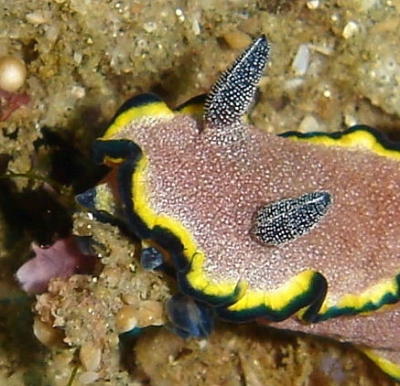
Concerning message #17585:
Hi Bill,
Following your message on the G. cincta feeding, I have been through all my photos on this nudi, but as you say it is difficult to determine whether they are feeding. I have selected a couple of photo that might be useful as they appear to be showing an interest in something. I can't determine what they are showing an interest in. We appear to have 2 separate colour forms here.
I also have a number of photos of them on all sorts of different structures. If you are interested let me know, or else just ignore these pictures,
Locality: Sodwana Bay, 20 metres, South Africa, Indian Ocean, various, reef. Length: 35 mm. Photographer: Colin Ogden.
regards
Colin
scubaco@iafrica.com
Ogden C. M., 2006 (Sep 8) Re: Glossodoris cincta - sponge association. [Message in] Sea Slug Forum. Australian Museum, Sydney. Available from http://www.seaslugforum.net/find/17634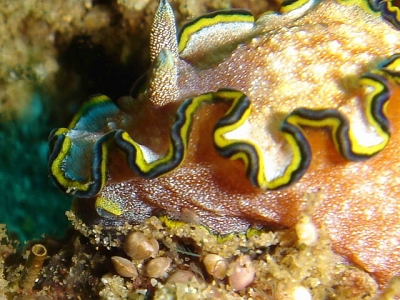
Thanks Colin,
As you say, they seem to be taking an interest in something, but I am afraid they are keeping whatever it is well hidden. All I can suggest is for you to persevere and if you get the opportunity, nudge their heads to see if they are attached, and if they appear to be stuck, be very annoying and carefully remove them to see and photograph any sign of a hole or 'grazing'. I know its often not practical to try precision 'poking and prodding' in the field, but hopefully now and then an opportune moment will occur.
Best wishes,
Bill Rudman
Glossodoris cincta - sponge association
August 23, 2006
From: Bill Rudman
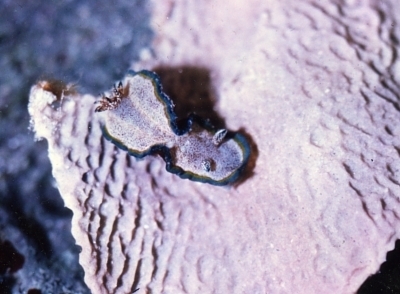
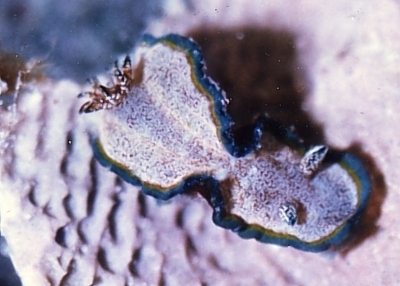
While tidying up some old photographic files recently I found this valuable photo which was kindly sent to me by Richard Willan many years ago, of one of the colour forms of Glossodoris cincta. It includes the following note:
"Found live on Phyllospongia papyracea.. SCUBA 25 ft on sand near coral, off Champagne Beach, Hog Harbour, Espiritu Santo Is., Vanuatu. coll R.C. Willan. 1 August 1976. " [Glossodoris specimen AM C462529].
It has been difficult to find good feeding information on Glossodoris cincta, not because it is particularly uncommon, but because it seems to feed on sponges which are often overgrown with algae, or partially covered in detritus. Glossodoris cincta appears to be restricted to thorectids. The very good colour match between the nudibranch and the sponge in Richard's photo, suggests to me that it may be worth making a special effort in identifying the sponges the various colour forms of G. cincta is found on. Although I could find no obvious anatomical differences between the forms when I revised this group, that does not mean that further studies may show there is more than one species. Certainly if the various colour patterns could be isolated to different sponges it would be worth re-examining the G. cincta 'colour group'.
Best wishes
Bill Rudman
billr@austmus.gov.au
Rudman, W.B., 2006 (Aug 23) Glossodoris cincta - sponge association. [Message in] Sea Slug Forum. Australian Museum, Sydney. Available from http://www.seaslugforum.net/find/17585Glossodoris cincta from the Red Sea
June 24, 2006
From: Lior Harari
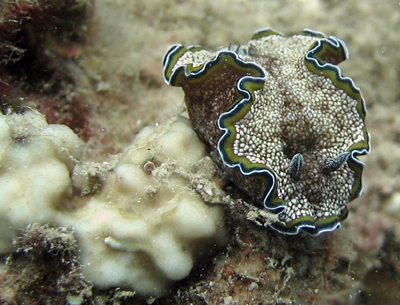
Hi,
I enjoyed discovering your forum. What a great way to collect scientific data.
Here is another Glossodoris cincta for your collection.
Locality: "Dekel" Beach, Eilat, 20 meters, Israel, Red Sea, 16 june 2006. Photographer: Lior Harari.
Lior.
hararilior@yahoo.com
Harari, L., 2006 (Jun 24) Glossodoris cincta from the Red Sea. [Message in] Sea Slug Forum. Australian Museum, Sydney. Available from http://www.seaslugforum.net/find/16937Dear Lior,
Glad you like the Forum. I don't suppose you would know if the white lumpy thing on which the Glossodoris is sitting is a sponge or coral would you?
Best wishes,
Bill Rudman
Glossodoris cincta from North Sulawesi
December 14, 2005
From: Erwin Kodiat
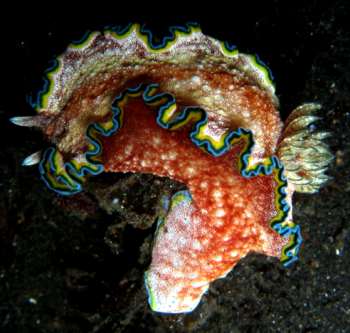
Hi Bill,
I found this Glossodoris cincta in Lembeh Strait.
Locality: Lembeh, North Sulawesi, Indonesia. Moluccas Sea. Depth: 12 meters. Length: 60 mm. 4 November 2005. Sandy. Photographer: Erwin Kodiat.
Erwin Kodiat
ungu@terong.com
Kodiat, E, 2005 (Dec 14) Glossodoris cincta from North Sulawesi. [Message in] Sea Slug Forum. Australian Museum, Sydney. Available from http://www.seaslugforum.net/find/15469Thanks Erwin,
It's good to get a fuller idea of the range of the different colour forms of this species
Best wishes,
Bill Rudman
Glossodoris cincta from Malaysia
December 13, 2005
From: Noor Hadi Ismail
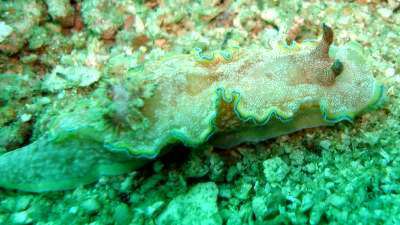
I took photograph of this nudibranch as attached and I think it's a Glossodoris. Can you please confirm it for me.
Locality: Pulau Jarak, Perak, Malaysia. Straits Of Malacca. Depth: abt 10 metres. 27 November 2005. Sandy bottom. Photographer: Noor Hadi Ismail
Thank you.
Noor Hadi Ismail
nhadi@tm.net.my
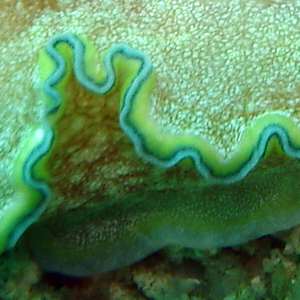
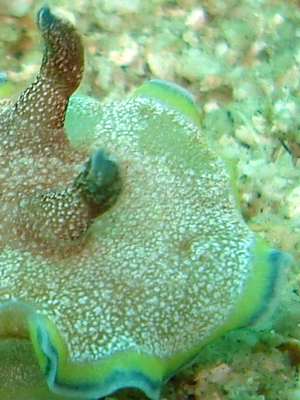
Dear Hadi,
This is Glossodoris cincta
Best wishes,
Bill Rudman
Color form of Glossodoris cincta? from the Philippines
October 20, 2005
From: Paul Osmond
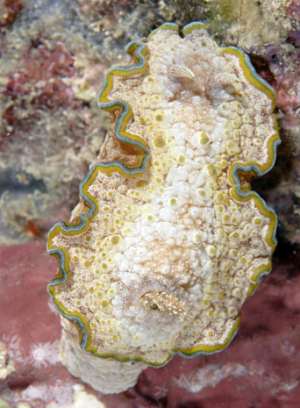
Hi Bill,
Found this nudibranch on a night dive off of Moalboal, The Philippines on a reasonably shallow reef.
Locality: Moalboal, Cebu, The Philippines. Depth: 10 m. Cebu, The Philippines. Length: 50 mm. July 17th 2005. Shallow coral reef, shore dive, night. Photographer: Paul T. Osmond
I think it is a color form of Glossodoris cincta as I couldn't see any other close matches on the site. Really unsure due to the mainly white body, although the shape and the margin bands seem to match up.
Yours,
Paul
www.deepseaimages.com
marriard@deepseaimages.com
Osmond, Paul T., 2005 (Oct 20) Color form of Glossodoris cincta? from the Philippines. [Message in] Sea Slug Forum. Australian Museum, Sydney. Available from http://www.seaslugforum.net/find/14637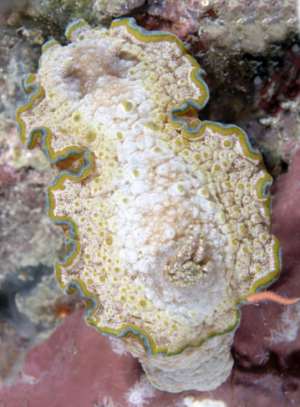
Dear Paul,
This is the common western Pacific form of G. cincta. I am pretty sure that the white coating over the central part of the mantle and the sides of the foot are from secretions from small glands it has all over its body which secrete a white milky secretion when the animal is 'stressed'. There are a group of species of Glossodoris which do this.
Best wishes,
Bill Rudman
Glossodoris cincta from Bali
May 14, 2005
From: Sabine Noack
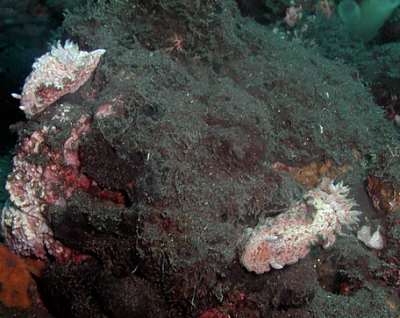
Dear Bill,
Here are 3 photos of Glossodoris cincta taken in Bali. All were taken in shallow Water (~6m) close to the beach right in front of the Liberty wreck.
I spotted the pair in the upper photo slowly crawling across a mud covered sponge (?), they seemed to be feeding (?). The closeups show the typical Indonesian coloring.
Locality: Tulamben, Liberty Wreck, Bali, Indonesia. Depth: 6 m. Length: 4-5 cm. 02 October 2002. muddy, close to beach. Photographer: Sabine Noack
Sabine Noack
dive@snoack.de
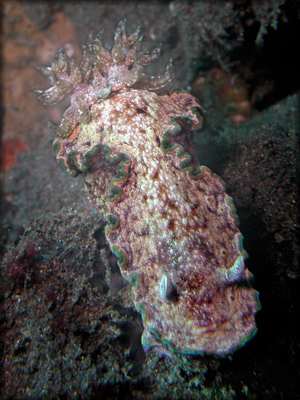
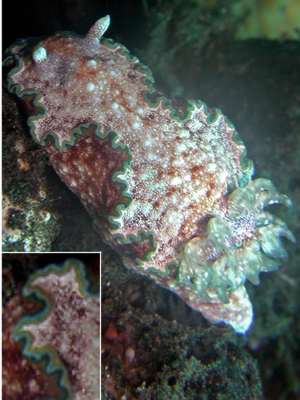
Dear Sabine,
Thanks for these. I agree they do seem to be associated with a sponge but I'm afraid its too obscured to identify from a photo.
Best wishes,
Bill Rudman
Glossodoris cincta from Singapore
April 25, 2005
From: Lim han peng
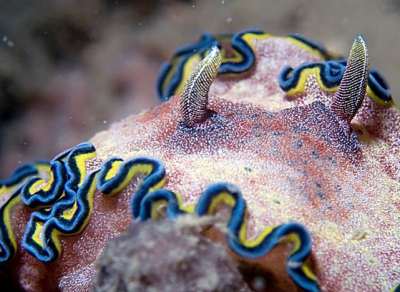
Hi Bill,
Here are some images I took of a Glossodoris cincta we found.
Locality: Pulau Hantu, Singapore. South China Sea. Depth: 12 m. Length: 80 mm. 20 March 2005. Jetty, Silt covered area. Photographer: hp lim
Lim han peng
limhp@hotpop.com
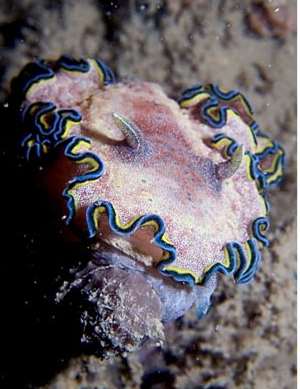
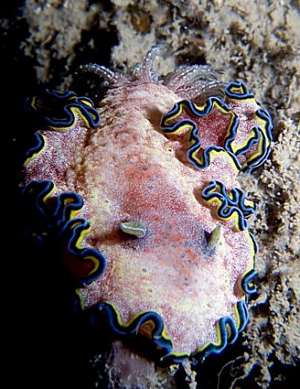
Thanks hp,
Bill Rudman
Glossodoris cincta from Mozambique
January 28, 2005
From: Charles Rowe
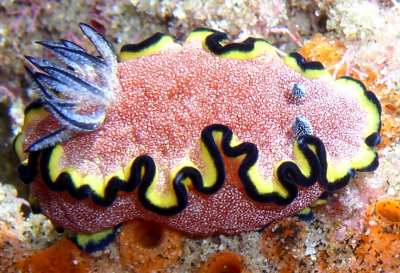
Hi Bill,
Here is another nudi I would like identified.
Creche, Ponto Malongame, Mozambique. 26 November 2004. 16 metres
See ya.
Charles
Charles.rowe@gmsa.com
Rowe, C., 2005 (Jan 28) Glossodoris cincta from Mozambique. [Message in] Sea Slug Forum. Australian Museum, Sydney. Available from http://www.seaslugforum.net/find/13048Dear Charles,
This is the western Indian Ocean colour form of Glossodoris cincta.
Best wishes,
Bill Rudman
Glossodoris cincta ? from Papua New Guinea
January 29, 2004
From: Jerry Kane
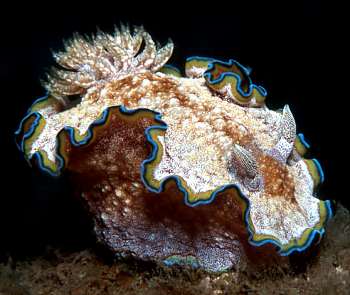
Dear Bill,
Local diving has been blown out for a couple weeks so I've been organizing old slides and came across this nudibranch shot in October 2000 at a muck site in Milne Bay, Papua New Guinea. Depth was probably 30 feet.
Except for different coloration, it looks to my uneducated eye like Glossodoris cincta in H. Debelius' Indo-Pacific field guide. Can you help with any information on it please?
Thank you.
Jerry Kane
Hawaii
kanej@hawaii.rr.com
Kane, J., 2004 (Jan 29) Glossodoris cincta ? from Papua New Guinea. [Message in] Sea Slug Forum. Australian Museum, Sydney. Available from http://www.seaslugforum.net/find/12004Dear Jerry,
It is indeed Glossodoris cincta. Like most tropical nudibranchs, we don't know that much about it, but have a look at the Fact Sheet, and what is in the messages attached below
Best wishes
Bill Rudman
Feeding habits of two species of Glossodoris
December 8, 2003
From: Sarah
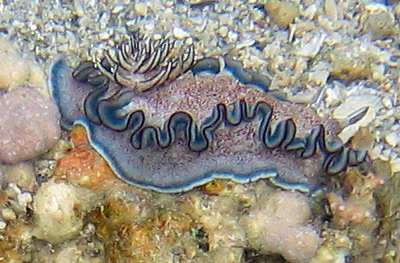
Dr. Rudman-
I'm an undergrad at University of California [Berkeley], and I've spent the last 3 months (Sept - Nov, 2003) looking at preferential feeding in Glossodoris hikuerensis [upper photo] and Glossodoris cincta [lower photos] in Moorea, French Polynesia. Both species were shown to prefer a black sponge, but I'm having trouble identifying it. Any ideas on what it might be? The nudis I studied were located in shallow water (1-3 meters deep) on a Porites dominated fringing reef. Also, I've seen both species feeding on the algal turf that is prevalent in the area, but very little of the literature mentions omnivory in this genus. The pic of G. cincta I've included shows one feeding on this algal cover.
Sarah
nyoink77@yahoo.com
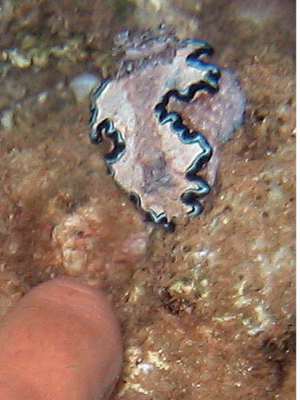
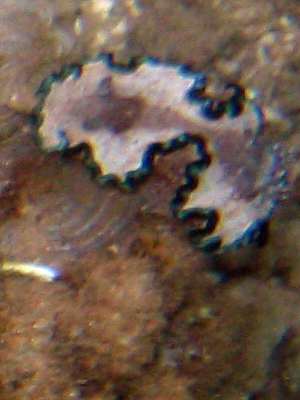
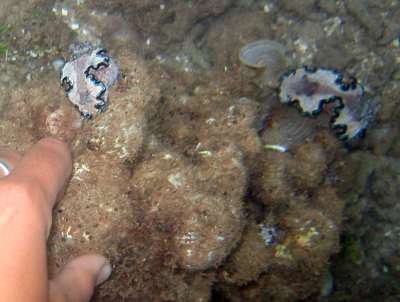
Dear Sarah,
This sounds like an interesting project and I look forward to more information when you get time to write up your observations.
There are a couple of records on the Forum of G. cincta feeding on a black sponge [message 1, message 2]. If you have a photo of the sponge it might be possible to get it identified.
I find it difficult to accept the possibility of these animals being omnivorous, that is feeding on a algal turf as well as sponges - though of course if you have evidence of stomach contents, or even direct evidence that they everted their pharynx and ingested algae, I would have to agree. However animals that eat animal tissue, need a quite different physiology and gut anatomy to that of a herbivore. Omnivores are quite rare in nature. Some sponges form a thin layer over rocks, and the colonies are often covered with algal growths, so it is possible that these slugs look as though they are grazing the algal turf when in fact they are eating an underlying layer of sponge.
I look forward to more information on the this intersting observation
Bill Rudman
Are these two the same animal?
October 9, 2003
From: Gary Cobb
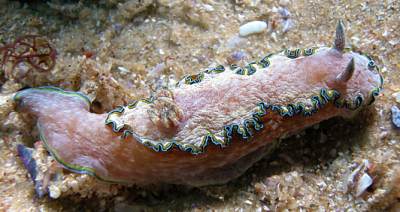
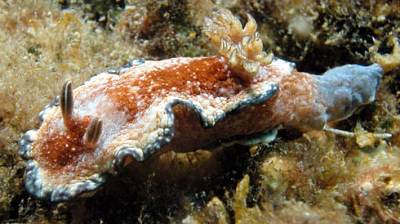
Hi Bill!
Please find attached two photos.
Upper: Flinders Reef, north of Moreton Island, Queensland, Australia. 26m depth Lower: off Mooloolaba, Queensland, Australia 18m depth.
Are either or both these Glossodoris cincta?
Thanks for you help.
Gary Cobb
gary@cobb.com.au
Cobb, G., 2003 (Oct 9) Are these two the same animal?. [Message in] Sea Slug Forum. Australian Museum, Sydney. Available from http://www.seaslugforum.net/find/11153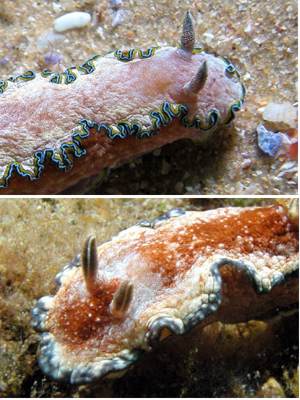
Dear Gary,
Your upper photo is the typical West Pacific colour form of Glossodoris cincta. If you look at the photos on the species Fact Sheet you will see I have identified a 'Philippines - Indonesia colour form' which is very similar to your lower photo. When I examined the anatomy of thses animals I could find no consistent differences between the 3 possible 'colour forms' so decided to leave them as one species, each colour form occurring in a specific geographic area. I am not sure if your animal is a rather lost 'Philippines - Indonesia colour form' or whether it is something different. I guess it is best to think of it as 'Glossodoris cf. cincta'. All we can do at this stage is to let more material accumulate until a clearer pattern emerges. It is an interesting animal.
Best wishes
Bill Rudman
Glossodoris cincta from South Africa
July 14, 2003
From: Rudolph van Jaarsveld
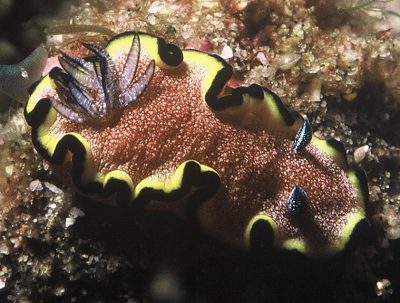
Hi Bill,
Please assist in the identification of this slug. I took the photo at Sodwana Bay, South Africa in May 2003 at a depth of 15 meters.
This photo was taken with an 80mm lens plus close-up lens.
Regards,
Rudolph.
rudolph@tcm.co.za
Jaarsveld, R., 2003 (Jul 14) Glossodoris cincta from South Africa. [Message in] Sea Slug Forum. Australian Museum, Sydney. Available from http://www.seaslugforum.net/find/10277Dear Rudolph,
This is the Indian Ocean form of Glossodoris cincta. I have a photo of this form from Tanzania on the species Fact Sheet. It is good to get further photos of this colour form. Gradually we should get a better picture of the colour variability of this species throughout its broad geographic range
Best wishes,
Bill Rudman
Glossodoris cincta laying eggs
June 23, 2003
From: Vasa P. Sirinupongs
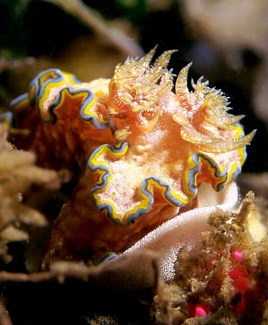
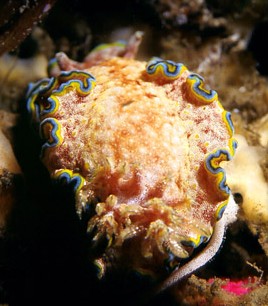
Hello Bill,
Here are photos of another nudi laying eggs.
Size: 1.5 inch
Depth: 15-18m
Dive site: Dumaguete, Philippines
Date: 3 May 2003
Vasa P. Sirinupongs
photo@scubadiving.com
Sirinupongs, V.P., 2003 (Jun 23) Glossodoris cincta laying eggs. [Message in] Sea Slug Forum. Australian Museum, Sydney. Available from http://www.seaslugforum.net/find/10275Thanks Vasa,
This is Glossodoris cincta. We have very few records of species of Glossodoris and their egg ribbons so this is a very valuable addition to our knowledge
Best wishes
Bill Rudman
Glossodoris cincta - feeding
March 18, 2003
From: Mary Jane Adams
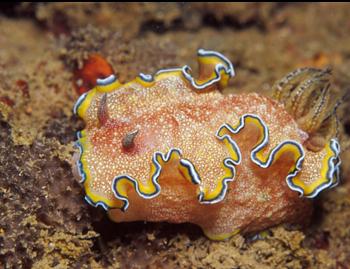
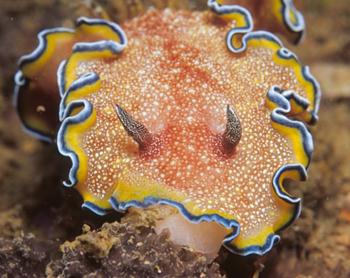
Hi Bill,
I found a couple of Glossodoris cincta on the Bang Sak wreck in the Andaman Sea near Khao Lak, Thailand, March 1, 2003. They were more colorful than the ones I have photographed in the Pacific.
This one was feeding on some of the dark brown sponge that grows in large clumps on the deck. The sponge was quite firm to the touch, so it must have been a chewy meal. The slug was about 10 cm long and 15 meters.
Best regards,
Mary Jane
divepng@yahoo.com
Adams, M.J., 2003 (Mar 18) Glossodoris cincta - feeding. [Message in] Sea Slug Forum. Australian Museum, Sydney. Available from http://www.seaslugforum.net/find/9427Thanks very much Mary Jane,
The nudibranchs of the Andaman Sea are proving to be a valuable source of information. If you by chance have a photo showing the sponge colonies in greater detail - even without a slug nearby - it would probably be a help in getting the sponge identified.
Best wishes,
Bill Rudman
Glossodoris cincta from southern Thailand
January 24, 2003
From: Priscilla Yeo
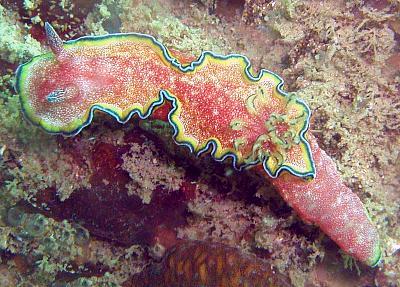
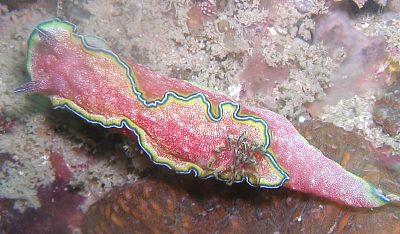
Dear Bill,
This specimen had been found at Laoliang Yei, Trang, south Thailand. depth between 6-8 meters. Only managed to observe one solitary creature, and it was hanging on to an almost 90 degree rock surface covered in algae and sponge. picture taken on 2nd jan 2003. Water is extremely calm at this site, and seems to be very well populated with quite a number of species of nudis. have seen at least 5 different types during my first dive alone!
Although not exactly discernable in the pictures attached, the yellow, black and blue rim actually extends all around the rim of the foot as well. Unsure if it is Chromodoris albopunctata, as it is without distinctive yellow foot, though the mantle, gill and rhino colouring are very similiar. Laoliang Yei itself is mainly composed of limestone, and a great number of underwater caves can be found here.
Priscilla Yeo
prisla@singnet.com.sg
Yeo, P., 2003 (Jan 24) Glossodoris cincta from southern Thailand. [Message in] Sea Slug Forum. Australian Museum, Sydney. Available from http://www.seaslugforum.net/find/8904Dear Priscilla,
This is Glossodoris cincta. Interestingly it has the typical Western Pacific colour pattern.
Best wishes,
Bill Rudman
Glossodoris cincta with defensive mucus
January 11, 2003
From: Danny Van Belle
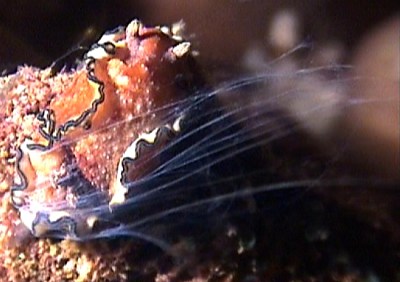
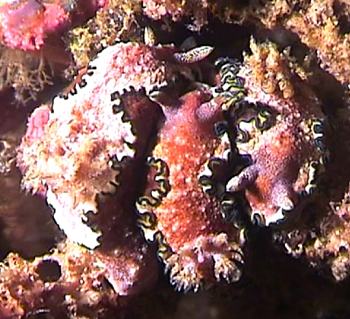
Hi Bill,
I think this is Glossodoris cincta again.
These were taken at Similan Islands, Thailand
Dive site: Snapper Alley - Koh Bangu
Depth: 7m
Date: January 2002
Cheers,
Danny
dannyvb@hotmail.com
Van Belle, D., 2003 (Jan 11) Glossodoris cincta with defensive mucus. [Message in] Sea Slug Forum. Australian Museum, Sydney. Available from http://www.seaslugforum.net/find/8859Dear Danny,
It is indeed G. cincta. What is very interesting is your photo showing the milky defensive secretions from what I call the 'mantle glands'. European workers usually call them 'mantle dermal formations' or MDFs for short, because they have found no secretory pores in histological studies. I haven't found any pores either, but I have certainly seen streaming secretions such as this. See the Defensive Secretions page and an earlier message where I discuss this more fully.
Best wishes,
Bill Rudman
Glossodoris cincta with missing rhinophore
December 13, 2002
From: Mary Jane Adams
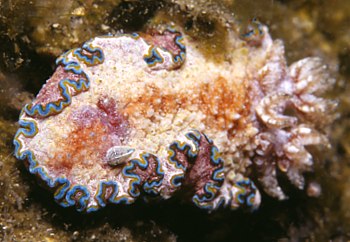
Hi Bill,
This Glossodoris cincta seems to be thriving despite it's missing rhinophore. Lembeh Strait, Sulawesi Island, Indonesia.
Divesite: Police Pier, November 17, 2002
Length: about 25mm. Depth: about 8m
Best regards,
Mary Jane
divepng@yahoo.com
Adams, MJ., 2002 (Dec 13) Glossodoris cincta with missing rhinophore. [Message in] Sea Slug Forum. Australian Museum, Sydney. Available from http://www.seaslugforum.net/find/8619Thanks Mary Jane,
Bill Rudman
Glossodoris cincta from North Sulawesi
October 8, 2002
From: Marli Wakeling
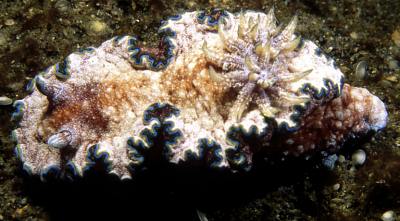
Hi Bill,
Here is a gorgeous creature I believe to be Glossodoris cincta. It was found on a sandy bottom, and was one of several seen over a couple of days.
Location: Police Pier, Lembeh Straight, North Sulawesi, Indonesia.
Date: July, 2002
Depth: 40 feet
Length: 12cm
Photograph: Marli Wakeling
Marli
scubamarli@excite.com
Wakleing, M., 2002 (Oct 8) Glossodoris cincta from North Sulawesi. [Message in] Sea Slug Forum. Australian Museum, Sydney. Available from http://www.seaslugforum.net/find/8115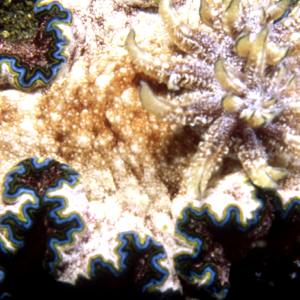
Dear Marli,
Yes this is the form of G. cincta with the yellow, black and blue bands arund the mantle edge
Bbest wishes,
Bill Rudman
Re: Glossodoris cincta
March 13, 2002
From: Jim Anderson
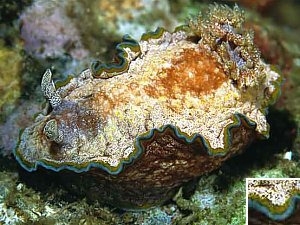
Dear Dr. Rudman,
Following from your comments about this colour form of G. cincta I note below links to two separate animals found last year in Lembeh Straits, Indonesia.
Date: 18 June 01
Size approx: 60 mm
Depth: 12 metres
Site: Lembeh Strait, North East Sulawesi
See http://www.bunaken.fsnet.co.uk/sss-gloss-cincta-01.htm
and
http://www.bunaken.fsnet.co.uk/sss-gloss-cincta-02.htm
Regards,
Jim A
jander4454@aol.com
Anderson, J., 2002 (Mar 13) Re: Glossodoris cincta. [Message in] Sea Slug Forum. Australian Museum, Sydney. Available from http://www.seaslugforum.net/find/6396Thanks Jim,
Its very close,
Cheers,
Bill
Glossodoris cincta from Okinawa
March 13, 2002
From: Bob Bolland
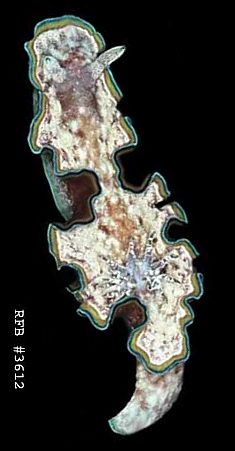
Hi Bill,
Re your comments to a recent post on the Forum by Stuart Hutchison, concerning the greenish submarginal mantle border of Glossodoris cincta being quite unusual, I'm enclosing an animal from Okinawa which is nearly identical to Stuart's Bali animal.
Data: RFB # 3612 / Notum: 44mm / from 3m / Seragaki, Okinawa / 16 Jul 1997
Cheers,
Bob
bollandr@rapid-link.ne.jp
Bolland, B., 2002 (Mar 13) Glossodoris cincta from Okinawa. [Message in] Sea Slug Forum. Australian Museum, Sydney. Available from http://www.seaslugforum.net/find/6397Thanks Bob,
Bill Rudman
Glossodoris cincta from Irian Jaya
March 13, 2002
From: Paul Krupela
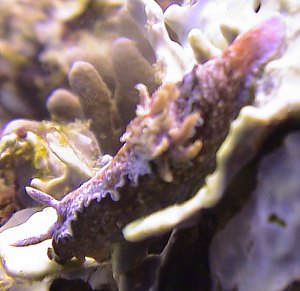
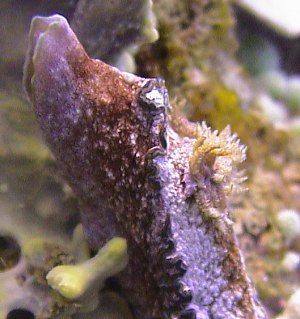
I photographed this nudibranch in March 2002 in the Rajaampat Islands off the northeast coast of Irian Jaya (Papua Barat) at a depth of about 25'. The area was rich in soft and hard corals, and the subject was found at first in a small sand patch among hard corals. It looks like Glossodoris cincta, but the coloration is somewhat different from what I've seen before. The attached photos are stills captured from video - I'll have better photos when I get them developed. Any help in identification would be appreciated.
Paul
pkrupela@earthlink.net
Krupela, P., 2002 (Mar 13) Glossodoris cincta from Irian Jaya. [Message in] Sea Slug Forum. Australian Museum, Sydney. Available from http://www.seaslugforum.net/find/6400Dear
Yes this is Glossodoris cincta. It looks quite like the photo from New Caledonia on the Fact Sheet. I would be happy to have a better photo for the record when you get them processed.
Best wishes,
Bill Rudman
Glossodoris cincta from Indonesia
March 10, 2002
From: Stuart Hutchison
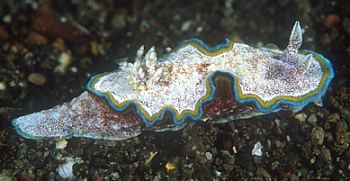
Hi Bill,
here's Glossodoris cincta from Bali, Indonesia on 23 Oct 2001. Length 40mm. Depth 5m.
Regards,
Stuart
stuart@stuarthutchison.com.au
Hutchison, S., 2002 (Mar 10) Glossodoris cincta from Indonesia. [Message in] Sea Slug Forum. Australian Museum, Sydney. Available from http://www.seaslugforum.net/find/6305Thanks Stuart,
This looks very similar in colour to the animal on the Fact Sheet from Christmas Island, in the Indian Ocean, just south of Java. The greenish submarginal mantle border is quite unusual. It would be interesting to know how widespread this colour form is.
Bill Rudman
Glossodoris cincta from Hong Kong
January 23, 2002
From: Bill Rudman & Brian Darvell
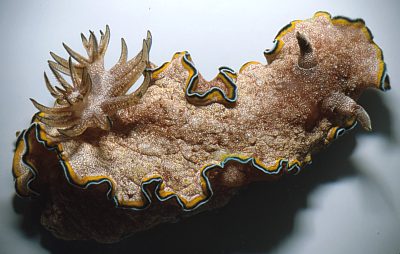
Here is some information and photos on Glossodoris cincta from Brian Darvell's Hong Kong collections.
This species is characterized by the white-specked brown body and the very sinuous mantle edge bordered with white, black and yellow. Three colour forms of this species have been recognized (Rudman 1986a) and specimens from Hong Kong are identical to specimens from northern Australia. It can grow to 55 mm.
Brian Darvell's photo is of the only specimen collected:
• AM C153710, 6 June 1987, Site 10.3, Pak Ma Tsui (Bay), Port Shelter, 10 m. Depth range: 5-10 m.
Reference:
• Rudman, W.B. & Darvell, B.W. (1990) Opisthobranch molluscs of Hong Kong. Part 1. Goniodorididae, Onchidorididae, Triophidae, Gymnodorididae, Chromodorididae, (Nudibranchia). Asian Marine Biology, 7: 31-79
Best wishes,
Bill Rudman & Brian Darvell
Glossodoris cincta from Tufi, PNG
October 22, 2001
From: Des Paroz


Hi Bill
Attached are 2 photos of what I believe to be Glossodoris cincta, taken in the Tufi Fjord in Papua New Guinea, September, 2001.
The first photo shows a nudi that was found on exactly the same spot (a protruberence standing clear of the bottom) three evenings in a row. I wonder if the slug was dead. This particular spot was about 2.5 - 3m in depth, directly under the Tufi Wharf (a public wharf). The second was found about 15m away in a depth of about 9-10m on a rubble bottom. Water temp was about 28C.
Within Tufi Fjord, there is very little current flow (none in our experience of 15 odd dives). Coral growth is spectacular, and immediately around the wharf area there is a great muck area created by debris dating to at least WW2 - Tufi was a PT boat base.
Best regards
Des Paroz
des@paroz.com
Paroz, D., 2001 (Oct 22) Glossodoris cincta from Tufi, PNG. [Message in] Sea Slug Forum. Australian Museum, Sydney. Available from http://www.seaslugforum.net/find/5421Thanks Des,
The 'protuberance' you found the animal on is in fact a sponge colony - most probably its food sponge. Mary Jane Adam's message mentions an animal on a similar black sponge. I think it is a species of Spongia or a close relative, but will need to check it out.
Best wishes,
Bill Rudman
Glossodoris cincta laying eggs
August 24, 2001
From: Mary Jane Adams
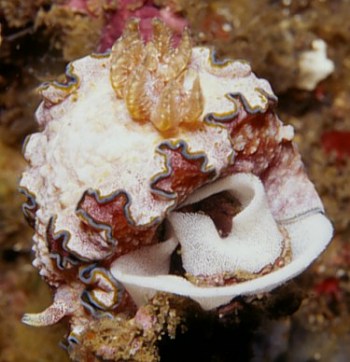
Hi Bill,
I recently returned from a dive trip to Indonesia and have some new photos for the Forum. I found this Glossodoris cincta laying eggs August 11, 2001 in the Lembeh Staits, Sulawesi. The divesite is aptly named "Nudi Falls."
Best regards,
Mary Jane
divepng@yahoo.com
Adams. M.J. , 2001 (Aug 24) Glossodoris cincta laying eggs. [Message in] Sea Slug Forum. Australian Museum, Sydney. Available from http://www.seaslugforum.net/find/5140Thanks Mary Jane,
Another egg ribbon we can now tick off the list of unknowns.
Bill Rudman.
Glossodoris cincta from Papua New Guinea
June 14, 2001
From: Stuart Hutchison
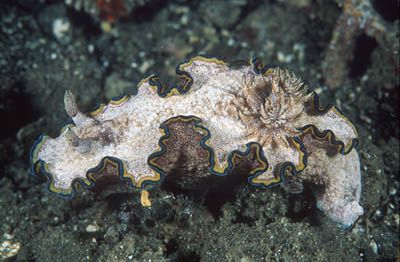
Bill,
Here's a nice Glossodoris cincta from Lawadi (pronounced Lavadi), Papua New Guinea. March 1998, 4m, 100mm long.
More to follow from Tulumben, Indonesia.
Regards,
Stuart
hutchco@tpg.com.au
Hutchison, S., 2001 (Jun 14) Glossodoris cincta from Papua New Guinea. [Message in] Sea Slug Forum. Australian Museum, Sydney. Available from http://www.seaslugforum.net/find/4489Thanks Stuart,
Bill Rudman
Re: Glossodoris cincta
September 1, 2000
From: Terry Gosliner
Bill,
You are right that calling the species Glossodoris sp. 2 in the South African book was largely a timing issue that your monograph on Glossodoris was not out by the time the book went to press. However, I am not entirely convinced that the animals that both Valda and I have seen from South Africa and that you have from Tanzania are the same species as Glossodoris cincta. The color pattern, different colored marginal and submarginal lines and black lines on the gills appear very different from specimens of G. cincta from both the western Pacific and the Indian Ocean. I recall that their radular teeth were very similar to those found in typical cincta, but I still think it is worthy of some additional investigation.
All the best,
Terry
tgosline@calacademy.org
Gosliner, T., 2000 (Sep 1) Re: Glossodoris cincta. [Message in] Sea Slug Forum. Australian Museum, Sydney. Available from http://www.seaslugforum.net/find/2956Thanks Terry,
I agree that ome of these 'species' are not easy to determine. At that time I considered the radular morphology and anatomy of the foregut and the reproductive system to be so similar in the three colour 'forms', that they best be considered geographic colour variations. Your comments suggest you have records of the western Pacific cincta colour form from the western Indian Ocean.
I guess its a bit like the Noumea haliclona species group in south eastern Australia. Nature sometimes is not kind when we want to put things into neat little boxes.
Best wishes,
Bill Rudman.
Glossodoris cincta from South Africa
August 30, 2000
From: Valda Fraser
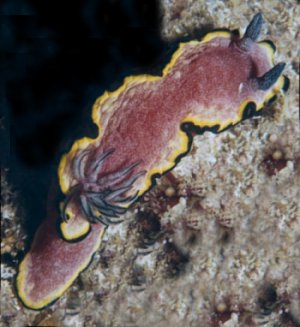
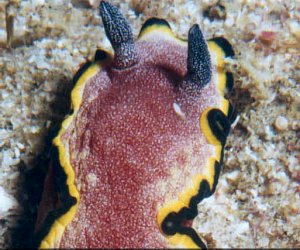
Dear Bill
Gosliner (1987) refers to this nudibranch as Glossodoris sp 2 (page 84). It looks like G. cincta to me. Can you tell me how they differ?
Locality: Sodwana, north coast KwaZulu-Natal, 10m, SOUTH AFRICA
Size: 40mm
Date: August 2000
Thanks.
Regards
Valda Fraser
iti04937@mweb.co.za
Fraser, V., 2000 (Aug 30) Glossodoris cincta from South Africa. [Message in] Sea Slug Forum. Australian Museum, Sydney. Available from http://www.seaslugforum.net/find/2892Dear Valda,
This is the species Terry called Glossodoris sp. 2. We now consider it a colour form of Glossodoris cincta, but while Terry was publishing his book, I was revising the taxonomy of this group of chromodorids. At that time the taxonomy of these animals was in a bit of a mess and this colour form was certainly not what was considered to be the 'typical' colour form of G. cincta. So Terry leaving it unnamed was a sensible move and although I can't speak for him, I don't think it means he considers it distinct from G. cincta. Its just our work wasn't well synchronised.
See the colour photos of the three colour forms at the top of the page.
Best wishes,
Bill Rudman.
Glossodoris cincta from Papua New Guinea
March 21, 2000
From: Mary Jane Adams
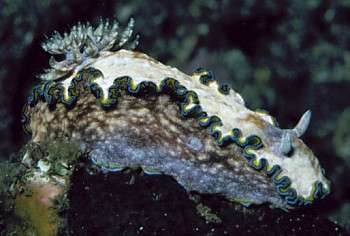
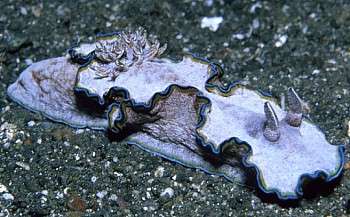
Dear Bill,
Here are two nudibranchs I found at Luadi, Milne Bay Province, PNG. This is a sandy bay with patch reef that is home to many opisthobranch species. The first one (upper)was about 35 mm long, sitting on a black sponge at 6 meters, Nov. 24, 1995. The second one (lower) was crawling across the sand at about the same depth. The gills were vibrating rapidly. The length was about 45 mm crawling. May 13, 1998. I believe they are both Glossodoris cincta.
Thanks,
Mary Jane Adams
mjadams@earthlink.net
Adams, M.J., 2000 (Mar 21) Glossodoris cincta from Papua New Guinea. [Message in] Sea Slug Forum. Australian Museum, Sydney. Available from http://www.seaslugforum.net/find/2102Dear Mary Jane,
Yes these are both Glossodoris cincta, another species which I haven't until now prepared a page for. There are at least three fairly well-defined geographic colour forms which I have illustrated above.
Your mention of one of them sitting on a black sponge is tantalising. The vigorously waving gills is characteristic of the species of Glossodoris. Many species of Glossodoris have a quite thick muscular body wall compared with the thin wall of most chromodorids. I have suggested in the past that the rapidly waving gills may be a response to the loss of the body wall as a means of oxygen exchange. Perhaps in Glossodoris the gills need to work a lot more efficiently than in thin-walled species.
Best wishes,
Bill Rudman.
